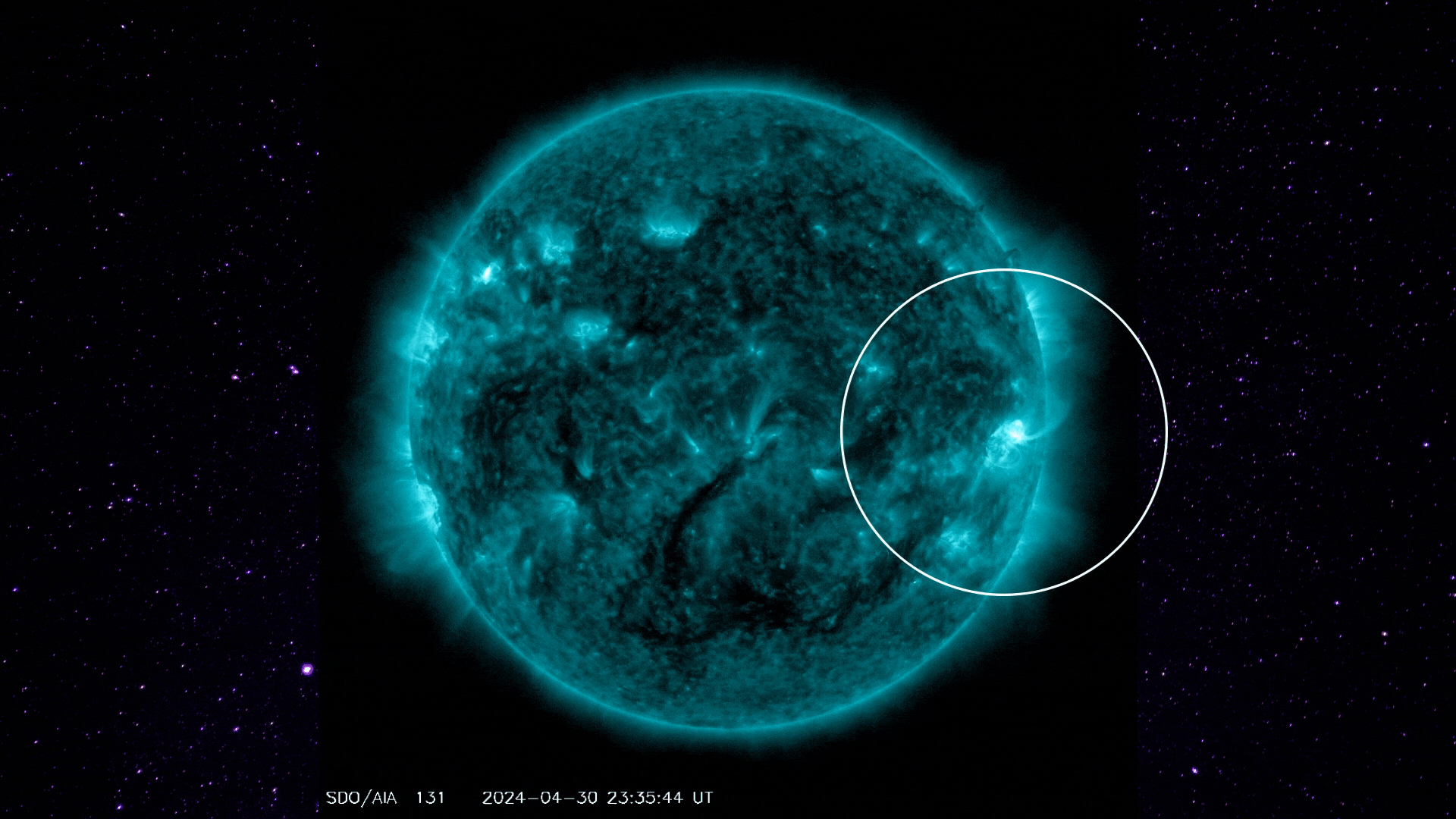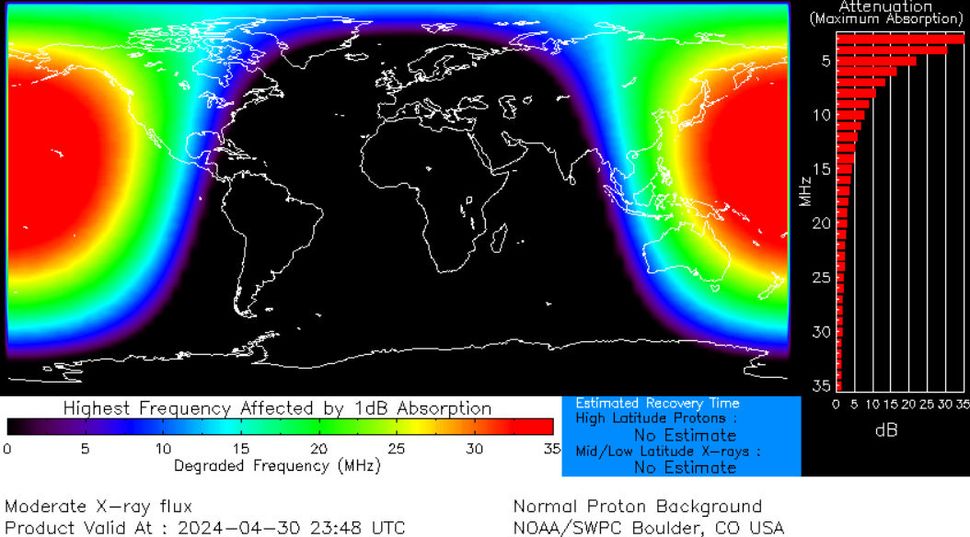
Posted on 05/01/2024 7:59:12 AM PDT by Red Badger
The solar flare is the most powerful eruption from sunspot region R3654 yet.
Last night (April 30), the sun released an extremely powerful solar flare triggering widespread radio blackouts across the Pacific region. The flare peaked at 7:46 p.m. EDT (2346 GMT) and ended shortly after at 7:58 p.m. EDT (2358).
Solar flares are eruptions from the sun's surface that emit intense bursts of electromagnetic radiation. They are created when magnetic energy builds up in the solar atmosphere and is released. Solar flares are categorized by size into lettered groups, with X-class being the most powerful. Then there are M-class flares that are 10 times less powerful than X-class flares, followed by C-class flares which are 10 times weaker than M-class flares, B-class are 10 times weaker than C-class flares and finally, A-class flares which are 10 times weaker than B-class flares and have no noticeable consequences on Earth.
Within each class, numbers from 1-10 (and beyond for X-class flares) describe a flare's relative strength. The recent April 30 flare clocked in at M9.53, according to Spaceweatherlive.com, measured by NASA's GOES-16 satellite, which puts it just a fraction below an X-class solar flare.
Shortwave radio blackouts like the one witnessed over the Pacific are common shortly after powerful solar flare eruptions due to the strong pulse of X-rays and extreme ultraviolet radiation emitted during the event. The radiation travels toward Earth at the speed of light and ionizes the top of Earth's atmosphere when it reaches us.

The solar flare is the most powerful eruption from sunspot region R3654 yet. (Image credit: NASA / SDO and the AIA, EVE, and HMI science teams / helioviewer.org. Annotated by Daisy Dobrijevic in Canva.) This ionization causes a higher-density environment that the high-frequency shortwave radio signals must attempt to navigate through to support communication over long distances. The radio waves that interact with electrons in the ionized layers lose energy due to more frequent collisions, and this can lead to radio signals becoming degraded or completely absorbed according to the National Oceanic and Atmospheric Administration (NOAA) Space Weather Prediction Center.
Radiation from the April 30 solar flare affected those on the sunlit portion of Earth at the time of the eruption, the Pacific regions. "Mariners and ham radio operators may have noticed loss of signal below 20 MHz for as much as 30 minutes after the flare's peak," according to Spaceweather.com.

High frequency radio blackout across the Pacific regions was reported by NOAA's Space Weather Prediction Center. (Image credit: NOAA/SWPC) Solar activity is ramping up as we approach solar maximum, the peak of solar activity during the sun's approximately 11-year solar cycle, indicated by the frequency of sunspots.
Despite the large number of sunspots currently visible on the sun's surface, our star has been relatively quiet in recent weeks. But not anymore.
The near X-class solar flare erupted from the sunspot region AR3654, the most powerful eruption from this region yet.
"It is always exciting when a sunspot region lives up to its potential. AR3654 has just done that." solar scientist Alex Young posted on X.
"Despite high sunspot numbers for the last couple of weeks, tonight's near X-class #SolarFlare is the first decent-sized flare in some time! When and where will the next X-class event come from?" solar astrophysicist Ryan French posted on X.
Solar scientists are keeping a watchful eye on the sun as it approaches solar maximum because solar activity can impact our lives on Earth.
Powerful flares can significantly affect spacecraft, satellites and ground-based technologies, traveling at the speed of light, and they don't give a lot of notice before striking. That's why numerous organizations — including NASA, NOAA and the U.S. Air Force Weather Agency (AFWA) — are monitoring the sun closely. These organizations can send out warnings to technology and infrastructure sectors vulnerable to solar flare activity so that appropriate precautions can be taken in the event of potentially harmful space weather.
"We can't ignore space weather, but we can take appropriate measures to protect ourselves," NASA says.
But there is no need to worry; so-called "killer flares" do not exist and although solar flares have the potential to significantly disrupt the technological world, they don't contain enough energy to do any lasting damage to Earth itself.
"Even at their worst, the sun's flares are not physically capable of destroying Earth," NASA says.
Truer words were never spoken.
Cycle 25 has been wild so far and promises to be one of the best in recent cycles for Amateur Radios Ops. Outages are never fun but it keeps it interesting.
You're correct, it's "when" not "if". And a bigger one is likely as well... Sooner or later, but not "never".
I'm 72, and have only a quarter of my life left (if that), so statistically I probably won't get to experience a Carrington-like event. But if one happens before I croak, that's okay with me. Everybody else might not feel the same, of course...
What!?! No picture of Ric Flair!?!
Better get your tin foil hats at the ready!................
But then again, not even the food pyramid I learned in health class in 1985 and was told is based on “science” is accurate.
Heck, for all I know, the sun pushes the earth out from its orbit as the solar winds intensify, because of the tidal effect and as the sun losses enough mass.
Who knows, all just theories we take as the truth. Not even the OOA theory is really for sure, not even evolution as a whole... Ask the Chinese and they will tell you man originated from Asia and that they have older skeletal remains than found in Africa.
***All I do know for sure is that on a cosmic level, I'm an ant, and my comprehension of the world around me is like that of an ant as well.***
I gave my entire domicile a giant Hershey Kiss-style cover.
Very true. It would be hard to revert back to my tribal ancestors way of living .
There would have been no natural winters, as the amount of smoke and other toxins in the high atmosphere created a “nuclear “ winter, bringing on the Younger Dryas event - one of the coldest periods ever.
This was a real climate change with weather patterns all over the world altering.
The event lasted that long because comet debris [ the Taurid meteor shower of today from the break up of 100 mile dia Comet Eniki ] continually rained down with some bodies a mile in diameter - these landed on the ice cap and remnant impact points are just now being discovered.
Could easily have been gamma rays and all life in that area wiped out or everyone made into a Hulk...
I read a science fiction story (the gist) of a boy who could see the future. His predictions came true and one day he said that all troubles would be over. People around the world were overjoyed. What he did not tell them was he saw that the sun was to go nova.
Lots of charged particles will hit the atmosphere creating more clouds and likely more cooling.
Disclaimer: Opinions posted on Free Republic are those of the individual posters and do not necessarily represent the opinion of Free Republic or its management. All materials posted herein are protected by copyright law and the exemption for fair use of copyrighted works.